Want to become a better leader? Start with these 12 must-read leadership books that cover team building, decision-making, and communication. Each book provides practical tools to help managers at any level tackle today’s challenges, from motivating employees to leading organizational change.
Quick Overview
- New managers: Learn team management basics and effective communication.
- Mid-level leaders: Focus on strategic thinking and conflict resolution.
- Senior executives: Dive into transformational leadership and culture shaping.
Top Picks:
- The 7 Habits of Highly Effective People - Personal growth and prioritization.
- How to Win Friends and Influence People - Building strong relationships.
- Good to Great - Driving meaningful organizational change.
- Start with Why - Crafting a vision and inspiring action.
- Leaders Eat Last - Building trust-driven team cultures.
- Drive - Motivating employees with autonomy and purpose.
- Lean In - Navigating leadership as women in the workplace.
- The Five Dysfunctions of a Team - Overcoming team challenges.
- Emotional Intelligence - Developing self-awareness and empathy.
- Daring Greatly - Embracing vulnerability for stronger leadership.
- The Amazon Way - Applying Amazon’s leadership principles.
Quick Comparison Table
| Book Title | Focus | Best For |
|---|---|---|
| The 7 Habits of Highly Effective People | Personal Growth | New managers |
| How to Win Friends and Influence People | Building Relationships | Strengthening interpersonal skills |
| Good to Great | Organizational Leadership | Leading change |
| Start with Why | Vision and Purpose | Inspiring teams |
| Leaders Eat Last | Team Culture | Building trust and collaboration |
| Drive | Motivation | Engaging employees |
| Lean In | Career Growth | Women in leadership roles |
| The Five Dysfunctions of a Team | Team Challenges | Resolving team issues |
| Emotional Intelligence | Self-Awareness | Improving emotional skills |
| Daring Greatly | Vulnerability in Leadership | Leading with courage |
| The Amazon Way | Strategic Thinking | Thriving in fast-paced environments |
How to Start: Choose a book that matches your leadership challenge, set a goal to read 30 minutes daily, and apply one new concept each week. Leadership growth starts with small, actionable steps.
Top 10 Leadership Books Every Leader Should Read
Reading Guide
This guide is designed to help you get the most out of each book, with a focus on team building, decision-making, and communication. Use these tips to make your reading both practical and impactful.
Choose Books That Fit Your Leadership Role
- New managers: Look for books that cover team management basics and effective communication.
- Mid-level leaders: Focus on topics like strategic thinking and handling conflicts.
- Senior executives: Opt for books on leading transformational change and shaping organizational culture.
Address Your Current Challenges
Start by identifying what you're struggling with as a leader. If engaging your team is a problem, pick books on motivation or employee growth. Struggling with strategic decisions? Go for books that offer clear decision-making frameworks.
Have a Plan to Apply What You Learn
Make sure the ideas stick by following these steps:
- Take notes on key points.
- Test out one new concept each week.
- Share what you’ve learned with your team or a mentor.
Pick Books That Match Your Learning Style
Whether you prefer case studies, data-driven insights, or theoretical discussions, choose books that align with how you learn best. This makes it easier to stay engaged and retain information.
Set Manageable Reading Goals
Aim for 30 minutes of reading each day and plan to finish one book every 4–6 weeks. Focus on understanding and applying the content rather than just rushing through multiple books.
12 Top Leadership Books for Managers
Here’s a list of 12 must-read leadership books that provide managers with practical tools and strategies to excel.
The 7 Habits of Highly Effective People
Author: Stephen R. Covey
Key Ideas: Focuses on personal leadership by promoting proactivity, goal setting, and prioritization. It also emphasizes building effective relationships and continuous self-improvement.
Skills Taught: Personal leadership, strategic planning, relationship management
Format: Includes exercises and self-assessments
Price: $12.32; available in hardcover, paperback, and digital formats
How to Win Friends and Influence People
Author: Dale Carnegie
Key Ideas: Teaches how to build strong relationships by showing appreciation, avoiding criticism, and understanding others’ viewpoints.
Skills Taught: Communication, networking, conflict resolution
Format: Features real-life examples, practical advice, and chapter summaries
Price: $15.72; includes updated case studies
Good to Great
Author: Jim Collins
Key Ideas: Explores why some companies outperform others through concepts like Level 5 Leadership and the Hedgehog Concept.
Skills Taught: Strategic thinking, team leadership, organizational growth
Format: Based on research and case studies with actionable insights
Price: $12.95; includes data from multiple industries
Start with Why

Author: Simon Sinek
Key Ideas: Explains how leaders can inspire action by clearly communicating their purpose using the Golden Circle framework.
Skills Taught: Vision creation, motivation, aligning teams
Format: Includes real-world examples and the Golden Circle model
Price: $16.52; features leadership case studies
Leaders Eat Last

Author: Simon Sinek
Key Ideas: Discusses how leaders can build trust-driven cultures that prioritize team well-being and collaboration.
Skills Taught: Team building, trust development, fostering collaboration
Format: Combines scientific research with leadership stories
Price: $15.75; includes actionable strategies
Drive

Author: Daniel H. Pink
Key Ideas: Examines modern motivation through autonomy, mastery, and purpose, challenging traditional reward systems.
Skills Taught: Motivating employees, managing performance, boosting engagement
Format: Features research summaries, toolkits, and exercises
Price: $11.59; practical implementation tips included
Lean In
Author: Sheryl Sandberg
Key Ideas: Addresses challenges women face in the workplace and encourages pursuing leadership roles while balancing personal and professional life.
Skills Taught: Career growth, negotiation, balancing priorities
Format: Combines personal stories with research and advice
Price: $8.72; includes discussion guides
The Five Dysfunctions of a Team
Author: Patrick Lencioni
Key Ideas: Identifies common team issues like lack of trust and accountability and offers solutions to overcome them.
Skills Taught: Building trust, resolving conflicts, driving accountability
Format: Leadership fable with actionable frameworks
Price: $9.82; includes team assessment tools
Emotional Intelligence
Author: Daniel Goleman
Key Ideas: Highlights the importance of emotional intelligence - self-awareness, empathy, and relationship management - in achieving success.
Skills Taught: Emotional awareness, empathy, managing relationships
Format: Blends scientific research with practical advice
Price: $17.39; includes updated findings
Daring Greatly
Author: Brené Brown
Key Ideas: Encourages leaders to embrace vulnerability as a way to build stronger connections and lead with courage.
Skills Taught: Courageous leadership, trust building, creating meaningful connections
Format: Combines research with personal stories and exercises
Price: $11.00; focuses on leadership applications
The Amazon Way

Author: John Rossman
Key Ideas: Explores Amazon’s 14 leadership principles, including customer obsession and a bias for action.
Skills Taught: Driving innovation, customer focus, taking decisive action
Format: Includes case studies and practical guides
Price: $11.99; real-world examples from Amazon
Refer to the Quick Reference Table below for a side-by-side comparison of these books.
sbb-itb-1ae7b2a
Book Comparison Guide
Here’s a handy breakdown of each book's main focus and who it's best suited for.
Quick Reference Table
| Book Title | Focus | Best For |
|---|---|---|
| The 7 Habits of Highly Effective People | Personal Growth | New managers working on self-improvement |
| How to Win Friends and Influence People | Building Relationships | Developing stronger interpersonal skills |
| Good to Great | Leading Organizations | Driving meaningful change in companies |
| Start with Why | Vision and Purpose | Crafting a clear company mission |
| Leaders Eat Last | Team Culture | Strengthening team collaboration |
| Drive | Motivation | Increasing team engagement |
| Lean In | Career Growth | Advancing in your career |
| The Five Dysfunctions of a Team | Team Challenges | Tackling team dynamics issues |
| Emotional Intelligence | Self-Awareness | Improving emotional leadership skills |
| Daring Greatly | Leadership with Vulnerability | Leading with authenticity and courage |
| The Amazon Way | Strategic Thinking | Thriving in fast-moving, innovative environments |
Books can also be grouped by focus areas to help you pick the right one for your leadership goals:
- Team Building: Leaders Eat Last, The Five Dysfunctions of a Team
- Interpersonal Development: The 7 Habits of Highly Effective People, How to Win Friends and Influence People, Emotional Intelligence, Daring Greatly
- Strategic Leadership: Good to Great, Start with Why, The Amazon Way
- Employee Motivation: Drive, Lean In
Use this guide to align your leadership challenges with the right book, and start applying these insights in your workplace.
Using Leadership Concepts at Work
Bring leadership principles into your daily routine with a clear and structured approach.
Start with Learning Blocks
Set aside time each day to focus on one leadership idea. For example, if you're reading Leaders Eat Last, spend your morning observing how your team interacts and think about ways to prioritize their well-being.
How to Put Leadership Concepts into Action
Here’s a simple framework to make leadership ideas work for you:
-
Pick a Focus Area
Identify a key challenge to address. This could fall into categories like:- Building team trust and culture
- Leading strategically
- Personal development
- Improving communication
-
Set Clear Goals
Define specific, measurable targets. For instance, schedule one-on-one meetings to build trust with your team. -
Track Progress
Use metrics to evaluate your efforts, such as:- Team engagement scores
- Project completion rates
- Feedback from employees
- Clarity and effectiveness of communication
Daily Leadership Practices
| Leadership Area | Daily Activity | Outcome |
|---|---|---|
| Team Trust | Morning check-ins | Stronger collaboration |
| Strategic Vision | Weekly team alignments | Clearer objectives |
| Personal Growth | Daily reflection | Smarter decisions |
| Communication | Feedback sessions | Improved clarity |
Practical Tips for Applying Leadership
Build stronger connections with your team by:
- Holding weekly discussions to openly address challenges
- Partnering with other managers for accountability
- Testing new leadership ideas in low-pressure situations
"Management is dead. People development is the new way forward. It's not a fad; it's a foundation. Ignore it, and you'll be left behind. Embrace it, and you'll be a part of the revolution. Implement it, and you'll reap incredible benefits." - Matt Tresidder and Chris Heaslip
Turning Leadership into a Habit
Make leadership a regular part of your work life by:
- Starting with small, manageable changes
- Asking your team for feedback on your leadership style
- Tweaking your approach based on what works
Engage with leadership groups or book clubs to exchange experiences and gain new perspectives. This collaborative approach can help you tackle challenges more effectively and grow as a leader.
Conclusion
Using this guide, you can get the most out of every book you read. Developing leadership skills takes effort, self-awareness, and a commitment to keep learning. The list of 12 leadership books provides a clear path to becoming a better manager, no matter where you are in your leadership journey.
Start With Your Current Needs
Pinpoint the leadership challenges you're facing right now. Then, pick books that align with those challenges:
- For new managers: Look for books that cover basic leadership skills and principles.
- For mid-level leaders: Choose titles that tackle strategic thinking and managing organizational change.
Turn Learning Into Action
- Set a goal to read one book per month to stay on track.
- Create action steps based on each book’s main lessons.
- Gradually apply new strategies to your leadership style.
- Track your progress by gathering feedback from your team and monitoring performance.
Commit to Continuous Growth
These books blend timeless advice with modern approaches to help you handle challenges and build strong, adaptable teams. By focusing on practical steps, you can seamlessly integrate these lessons into your leadership journey.
What’s Next?
Choose a book that addresses your most urgent leadership challenge. Read through the descriptions to find the best fit, then apply the strategies that will have the biggest impact on your growth as a leader.
FAQs
How do I choose the best leadership book for my role and challenges?
To choose the right leadership book, start by identifying the specific skills or areas you want to improve, such as team building, communication, or strategic decision-making. Think about the challenges you’re currently facing in your role and look for books that address those topics directly.
Consider books tailored to your leadership level, whether you're a first-time manager, an experienced leader, or looking to develop a more inclusive leadership style. Exploring perspectives outside your own experience can also provide valuable insights to help you grow as a leader.
By focusing on your unique needs and career goals, you’ll be able to find a book that offers practical advice and actionable strategies to enhance your leadership skills.
How can I effectively apply lessons from leadership books to improve my management skills?
To bring leadership lessons into your daily management practices, start by focusing on actionable insights from key books. For example, use Radical Candor by Kim Scott to improve team communication through honest yet empathetic feedback. Incorporate strategies from Leaders Eat Last by Simon Sinek to foster trust and collaboration by prioritizing your team's well-being.
To handle challenges, apply principles from Extreme Ownership by Jocko Willink and Leif Babin, which emphasize taking responsibility and leading by example. For personal growth, use Atomic Habits by James Clear to build productive routines that align with your leadership goals. These practical steps can help you create a positive impact on your team and organization.
What’s the best way to track my growth after applying strategies from leadership books?
To track your growth after applying strategies from leadership books, start by regularly evaluating your leadership skills and noting specific improvements or changes. Seek honest feedback from your team, peers, or mentors to understand how your leadership style is evolving.
Set clear, measurable goals based on the book’s teachings and monitor your progress over time. Keeping a journal to document successes, challenges, and lessons learned can also help you reflect and stay focused on continuous improvement. Finally, revisit the books periodically to reinforce key concepts and adjust your approach as needed.


